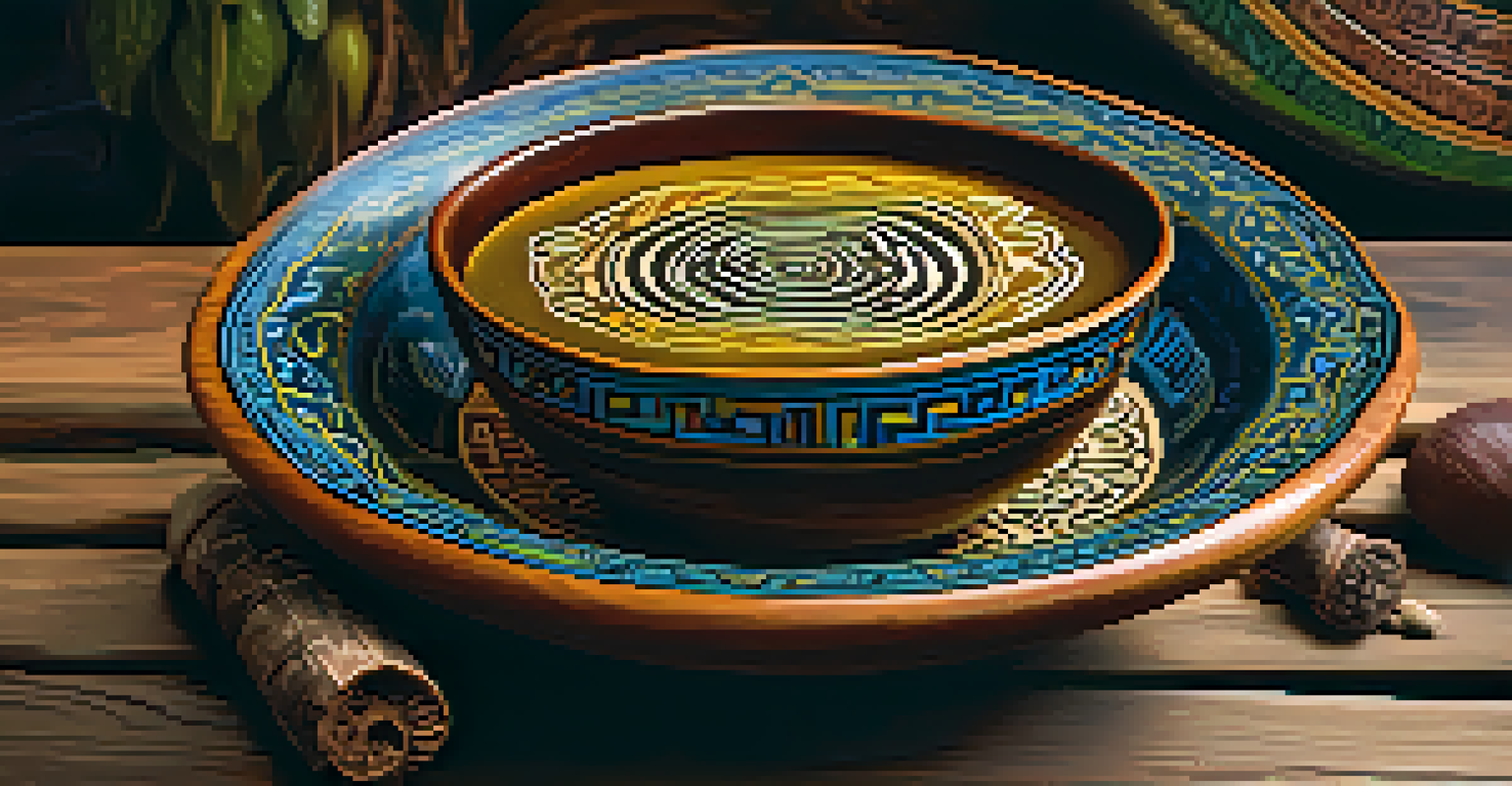Understanding Ayahuasca: A Guide for Integration Therapists

What is Ayahuasca and its Historical Context?
Ayahuasca is a powerful plant medicine traditionally used by indigenous cultures in the Amazon for spiritual and healing purposes. Its primary ingredients, the Banisteriopsis caapi vine and the Psychotria viridis leaf, create a brew that induces altered states of consciousness. This ancient practice has been passed down through generations, often involving shamanic rituals that connect participants with deeper aspects of themselves.
The greatest discovery of my generation is that a human being can alter his life by altering his attitude.
Many people are drawn to Ayahuasca for its potential to facilitate profound personal insights and emotional healing. In recent years, interest in Ayahuasca has surged beyond its origins, attracting individuals from diverse backgrounds seeking therapeutic benefits. Understanding its historical context is crucial for integration therapists who aim to support clients in navigating their experiences safely and effectively.
As more individuals partake in Ayahuasca ceremonies, the need for proper integration becomes evident. Integration refers to the process of making sense of and incorporating the insights gained during the experience into daily life. This is where therapists play a vital role in guiding clients through the often complex emotional landscapes that arise.
The Ayahuasca Experience: What to Expect
The Ayahuasca experience can vary greatly from person to person, influenced by factors such as mental state, intention, and the setting of the ceremony. Many describe it as a journey through their subconscious, marked by vivid visions and intense emotional releases. Understanding these variations is essential for integration therapists as they prepare to support clients post-ceremony.

Participants often encounter both beautiful and challenging aspects of their psyche during the experience. It’s not uncommon to face personal traumas or unresolved emotions, which can lead to catharsis. By anticipating this rollercoaster of emotions, therapists can help clients feel more grounded and prepared as they navigate their experiences.
Ayahuasca's Healing Potential
Ayahuasca is revered for its ability to facilitate personal insights and emotional healing through shamanic rituals.
Moreover, the setting in which Ayahuasca is consumed plays a significant role in shaping the experience. A supportive, safe environment can foster deeper connections and encourage openness, while a chaotic or intimidating space may hinder personal exploration. Integration therapists should be aware of these dynamics to better assist clients in their healing journey.
Navigating the Challenges of the Ayahuasca Journey
While Ayahuasca can lead to profound insights, it can also present significant challenges. Participants might encounter difficult emotions, traumatic memories, or even feelings of existential dread. For integration therapists, recognizing these potential hurdles is key to providing appropriate support and guidance.
Healing requires from us the courage to face our pain and not the fear of it.
Clients may leave an Ayahuasca experience feeling overwhelmed or confused about what they've encountered. It’s crucial for therapists to create a safe space for clients to unpack these emotions and make sense of their experiences. Encouraging journaling or art as tools for expression can be incredibly beneficial during this phase.
Additionally, some individuals may experience physical symptoms post-ceremony, such as fatigue or nausea. Addressing these physical aspects is just as important as the emotional ones, as they can significantly impact a client's ability to integrate their experience effectively. Therapists should be prepared to offer holistic support, encompassing both mind and body.
Integration Techniques for Ayahuasca Experiences
Integration is an ongoing process that involves several techniques to help clients blend their Ayahuasca insights into their daily lives. One common approach is talk therapy, where clients can verbalize their experiences and feelings. This dialogue helps in making sense of the often chaotic emotions that surface after an Ayahuasca journey.
Mindfulness practices, such as meditation or breathwork, can also play a significant role in integration. These techniques help clients stay present and grounded, allowing them to process their experiences without becoming overwhelmed. Encouraging clients to incorporate these practices can foster a deeper connection to their insights.
Importance of Integration Therapy
Integration therapy is crucial for helping individuals process and incorporate their Ayahuasca experiences into daily life.
Group integration sessions can provide a sense of community and shared experience, which can be incredibly healing. Hearing others' stories can help clients feel less isolated in their journey and validate their experiences. Integration therapists should consider facilitating these group sessions to enhance the support network for clients.
The Role of Integration Therapists in Ayahuasca Work
Integration therapists serve as vital guides for individuals who have participated in Ayahuasca ceremonies. Their role is to create a safe space where clients can explore their experiences without judgment. This compassionate support is essential for helping clients process and integrate their insights effectively.
Having a solid understanding of the Ayahuasca experience allows therapists to empathize with clients during their integration journey. They can offer tailored approaches that resonate with each client's unique experience and emotional landscape. This personalized care fosters trust and encourages deeper exploration.
Moreover, integration therapists can provide education about the potential psychological effects of Ayahuasca. By discussing topics such as emotional release, spiritual awakening, and the challenges of integration, therapists can equip clients with tools to navigate their journeys more effectively.
Building a Supportive Community for Integration
Creating a supportive community is crucial for individuals integrating their Ayahuasca experiences. Such a community can provide a sense of belonging and understanding, which can be incredibly comforting during the often tumultuous integration process. Integration therapists can play a key role in fostering these connections.
Encouraging clients to attend workshops, support groups, or online forums can help them find peers who have shared similar experiences. This network can offer emotional support, practical advice, and validation, making the integration journey feel more manageable. Sharing stories within a community can also spark new insights and perspectives.
Building Community Support
Creating a supportive community enhances the integration process by providing shared experiences and emotional validation.
Additionally, therapists can facilitate community-building events such as integration circles or group therapy sessions. These gatherings allow clients to share their experiences in a safe environment, promoting healing through collective understanding. A strong community can significantly enhance the integration process and provide ongoing support.
Ethical Considerations in Ayahuasca Integration Therapy
Ethical considerations are paramount in the realm of Ayahuasca integration therapy. Therapists must approach their work with sensitivity and respect for the cultural origins of Ayahuasca use. This involves understanding the significance of the ceremonies and the potential consequences of misappropriating these practices.
Informed consent is another critical aspect of ethical practice. Integration therapists should ensure that clients fully understand the risks and benefits associated with Ayahuasca experiences. This transparency fosters trust and empowers clients to make informed decisions about their healing journeys.

Lastly, therapists must be mindful of their own biases and limitations. Continuous education and self-reflection are essential in providing the best care for clients. By staying informed about the evolving landscape of Ayahuasca therapy, integration therapists can support their clients with integrity and respect.